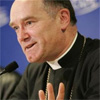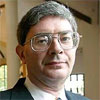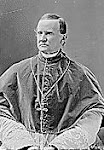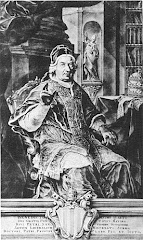 Last year, commenting on Pope Benedict XVI's historic visit to the United States, Bishop Bernard Fellay, Superior General of the SSPX, remarked:
Last year, commenting on Pope Benedict XVI's historic visit to the United States, Bishop Bernard Fellay, Superior General of the SSPX, remarked:And now, we have a perfectly liberal Pope, my very dear brothers. As he goes to this country [the United States] which is founded upon Masonic principles, that is, of a revolution, of a rebellion against God. And, well, he expressed his admiration, his fascination before this country which has decided to grant liberty to all religions. He goes so far as to condemn the confessional State. And he is called traditional! And this is true, this is true: he is perfectly liberal, perfectly contradictory. He has some good sides, the sides which we hail, for which we rejoice, such as what he has done for the Traditional liturgy.As Fr. John Zuhlsdorf (What Does The Prayer Really Say?) noted, Fellay's remarks are indicative of a point he has maintained: the greater dispute between the SSPX and Rome is not so much over questions involving liturgical reform (and the 'reform of the reform') -- on which there is a great deal of room for agreement -- or even the matter of the excommunications; rather, the chief problem hinges on the Society's objections to Vatican II's articulation of the principle of "religious liberty" and the relationship of civil and religious authority.What a mystery, my very dear brothers, what a mystery!
 This point was made recently in an article by George Weigel: "Rome’s Reconciliation: Did the Pope heal, or deepen, the Lefebvrist schism?" Newsweek January 26, 2009):
This point was made recently in an article by George Weigel: "Rome’s Reconciliation: Did the Pope heal, or deepen, the Lefebvrist schism?" Newsweek January 26, 2009):
... Lefebvre was also a man formed by the bitter hatreds that defined the battle lines in French society and culture from the French Revolution to the Vichy regime. Thus his deepest animosities at the council were reserved for another of Vatican Council II’s reforms: the council’s declaration that "the human person has a right to religious freedom," which implied that coercive state power ought not be put behind the truth—claims of the Catholic Church or any other religious body. This, to Lefebvre, bordered on heresy. For it cast into serious question (indeed, for all practical purposes it rejected) the altar-and-throne arrangements Lefebvre believed ought to prevail—as they had in France before being overthrown in 1789, with what Lefebvre regarded as disastrous consequences for both church and society.As Weigel rightly notes, the scandal over Richard Williamson's anti-semitism is but a sideshow; "what is at issue, now, is the integrity of the Church's self-understanding, which must include the authenticity of the teaching of Vatican Council II":
Marcel Lefebvre’s war, in other words, was not simply, or even primarily, against modern liturgy. It was against modernity, period. For modernity, in Lefebvre’s mind, necessarily involved aggressive secularism, anti-clericalism, and the persecution of the church by godless men. That was the modernity he knew, or thought he knew (Lefebvre seems not to have read a fellow Frenchman’s reflections on a very different kind of modernity, Alexis de Tocqueville’s "Democracy in America"); it was certainly the modernity he loathed. And to treat with this modernity—by, for example, affirming the right of religious freedom and the institutional separation of church and state—was to treat with the devil.
The conviction that the Catholic Church had in fact entered into such a devil’s bargain by preemptively surrendering to the modern world at Vatican Council II became the ideological keystone of Lefebvre’s movement. And the result was dramatic: Lefebvrists came to understand themselves as the beleaguered repository of authentic Catholicism—or, as the movement is wont to put it, the Tradition (always with a capital "T"). ...
Father Federico Lombardi, SJ, the pope's spokesman, emphasized to reporters on Jan. 24 that the lifting of the excommunications did not mean that "full communion" had been restored with the Lefebvrists. The terms of such reconciliation are, presumably, the subject of the "talks" to which Bishop Fellay referred in his letter. Those talks should be interesting indeed. For it is not easy to see how the unity of the Catholic Church will be advanced if the Lefebvrist faction does not publicly and unambiguously affirm Vatican Council II's teaching on the nature of the church, on religious freedom, and on the sin of anti-Semitism. Absent such an affirmation, pick-and-choose cafeteria Catholicism will be reborn on the far fringes of the Catholic right, just when it was fading into insignificance on the dwindling Catholic left, its longtime home.
Holy See - "no qualms" with the SSPX's criticism of the Council?
Taking issue with Weigel ("A bad year for the Neocon Catholics" RenewAmerica.com February 20, 2009), Brian Mershon asserts:Maybe Weigel has not read what Cardinal Ratzinger wrote to the Bishops of Chile in his 1988 address where he said that Vatican II was a pastoral Council. And as a pastoral Council, the "Declaration on Religious Liberty" must be understood "in light of Tradition" as Cardinal Ratzinger wrote in his 1988 address. In other words, the proper and orthodox Catholic understanding of the meaning of Dignitatis Humanae in light of the traditional teaching of the Social Kingship of Christ is only still being worked out within the Church. It surely does not negated the perennial teaching of the Social Kingship of Christ the King as Weigel asserts with his typical "altar and throne" analogy.Far from being a dogmatic document, the fact remains that there has been precious little theology done to show the connections between the Council's teaching on religious liberty and the continuous, unbroken line of teaching from multiple Popes previous to the Council that condemned "religious liberty." This is not to say it cannot be harmonized or reconciled, but merely that Weigel seems to posit that traditionalists must accept it as an article of Faith. It is not. And its theological implications have certainly not been defined nor well developed since the Council by theologians or the magisterium.
Likewise, Atheistane -- one of the more thoughtful (less knee-jerk) readers of WDTPRS -- comments:Weigel seems to regard DH, and its prescription for religious liberty and church-state relations, as a settled issue. He is a vigorous advocate for this view and he is vested in it. I can only note that DH was the most contested document at the Council, and stirred the greatest opposing vote (although it still passed comfortably). And that some very respectable (hardly traditionalist) scholars, such as Ernest Fortin and (Weigel’s friend) Russell Hittinger have raised real questions about the tensions between DH and previous Church teachings, and how we are to receive DH in continuity with the latter. Which is another way


























No comments:
Post a Comment